A new class of bilevel weak vector variational inequality problems
In this paper, we first introduce a new class of bilevel weak vector variational
inequality problems in locally convex Hausdorff topological vector spaces.
Then, using the Kakutani-Fan-Glicksberg fixed-point theorem, we establish
some existence conditions of the solution for this problem
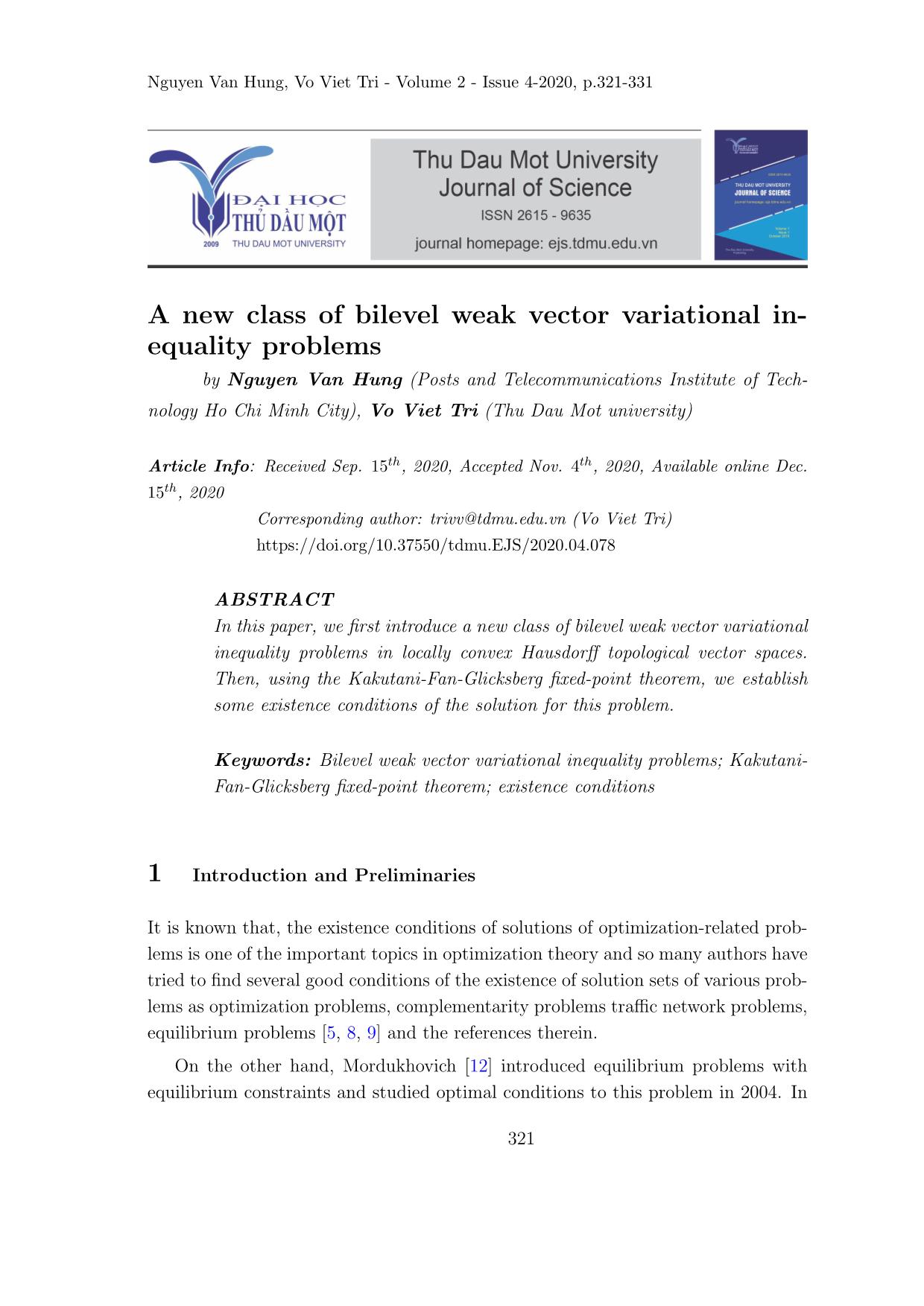
Trang 1
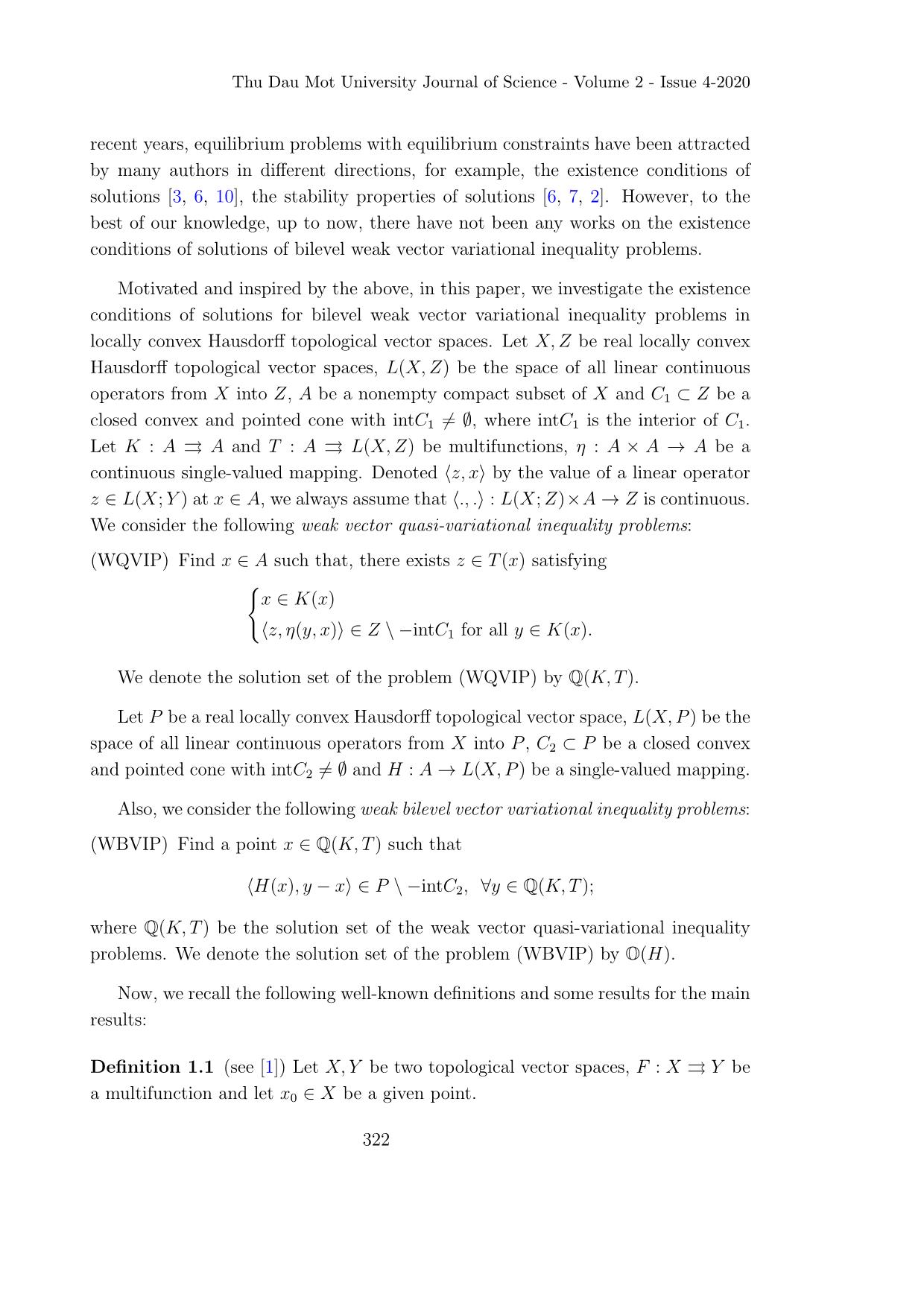
Trang 2
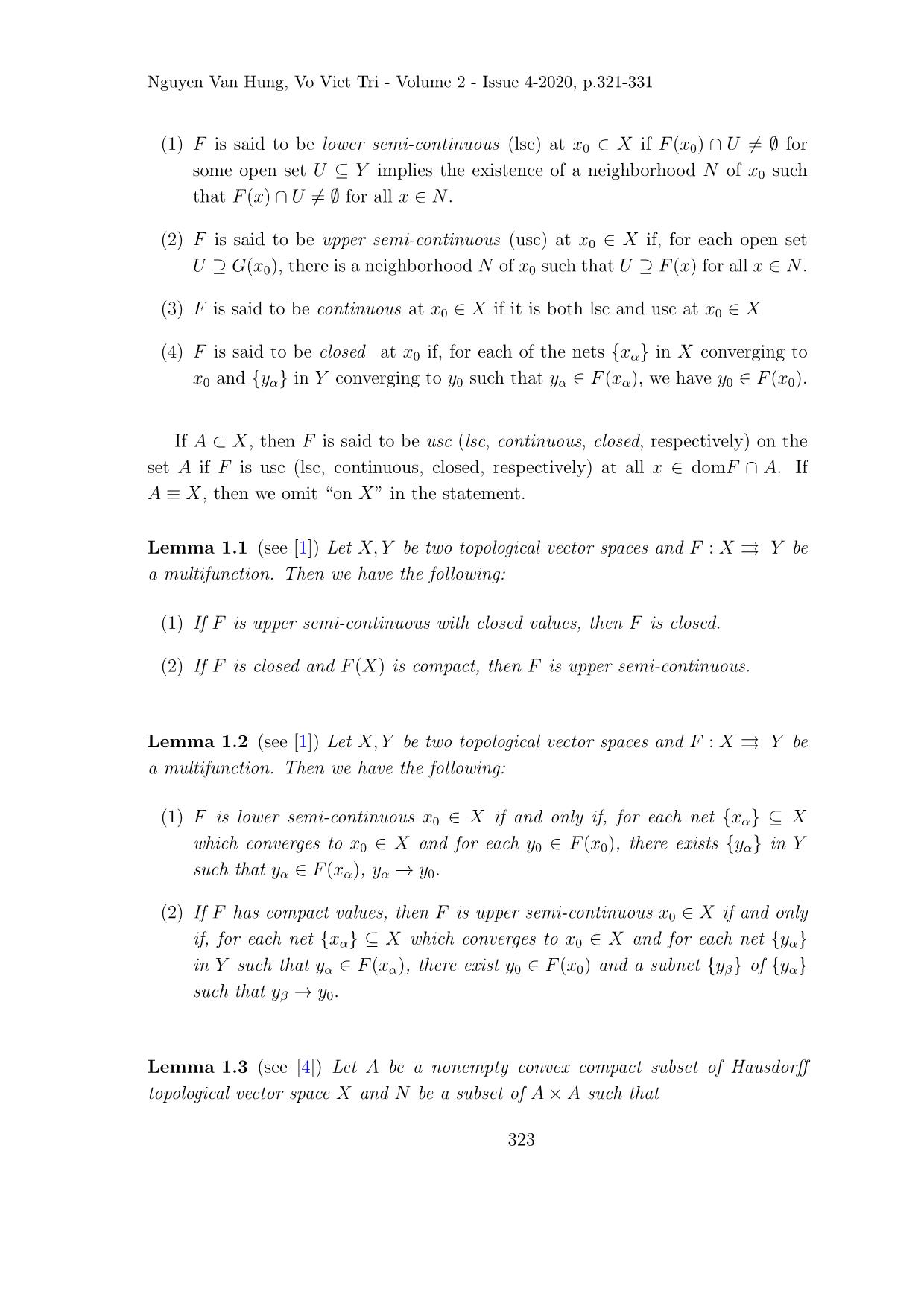
Trang 3
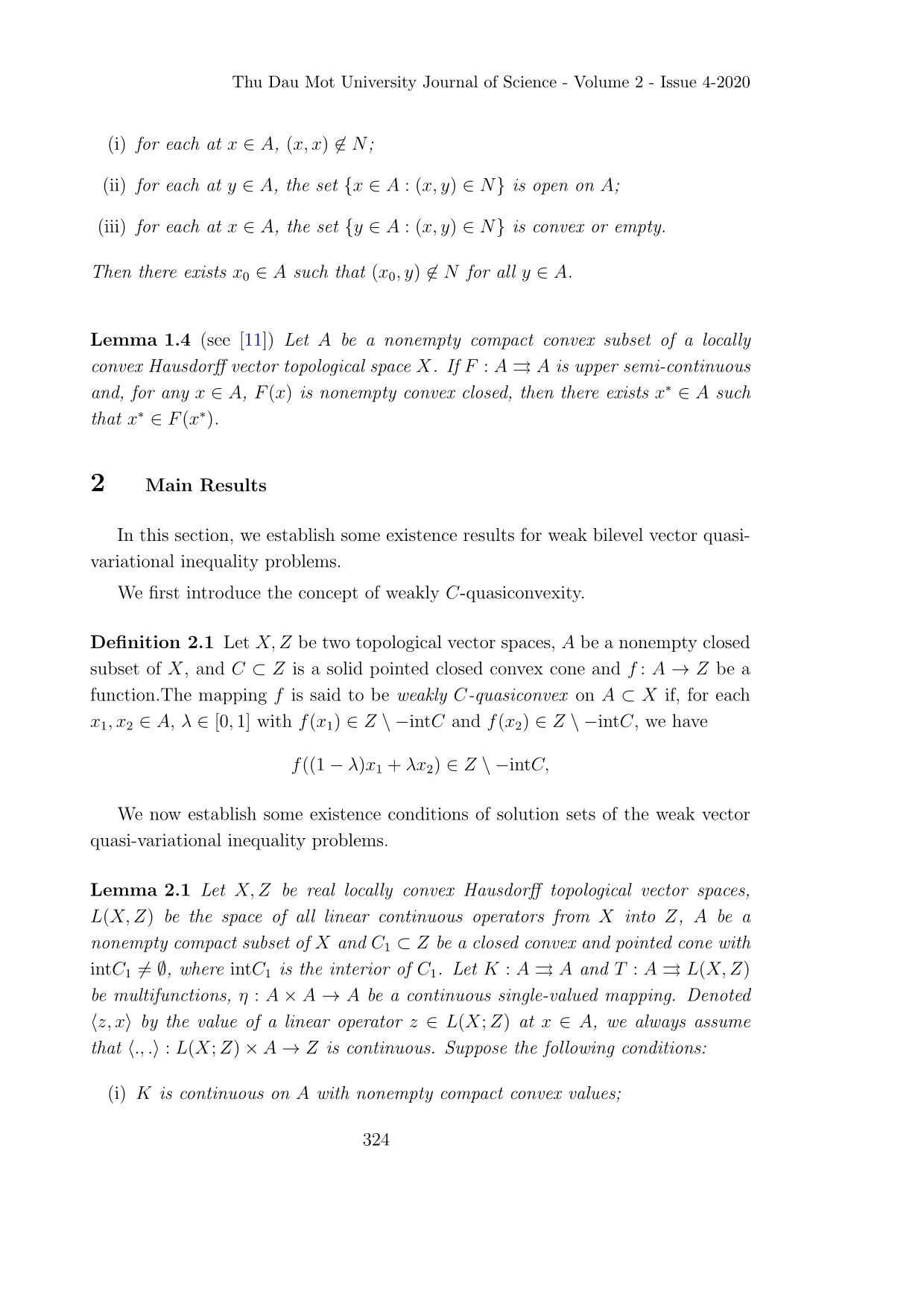
Trang 4
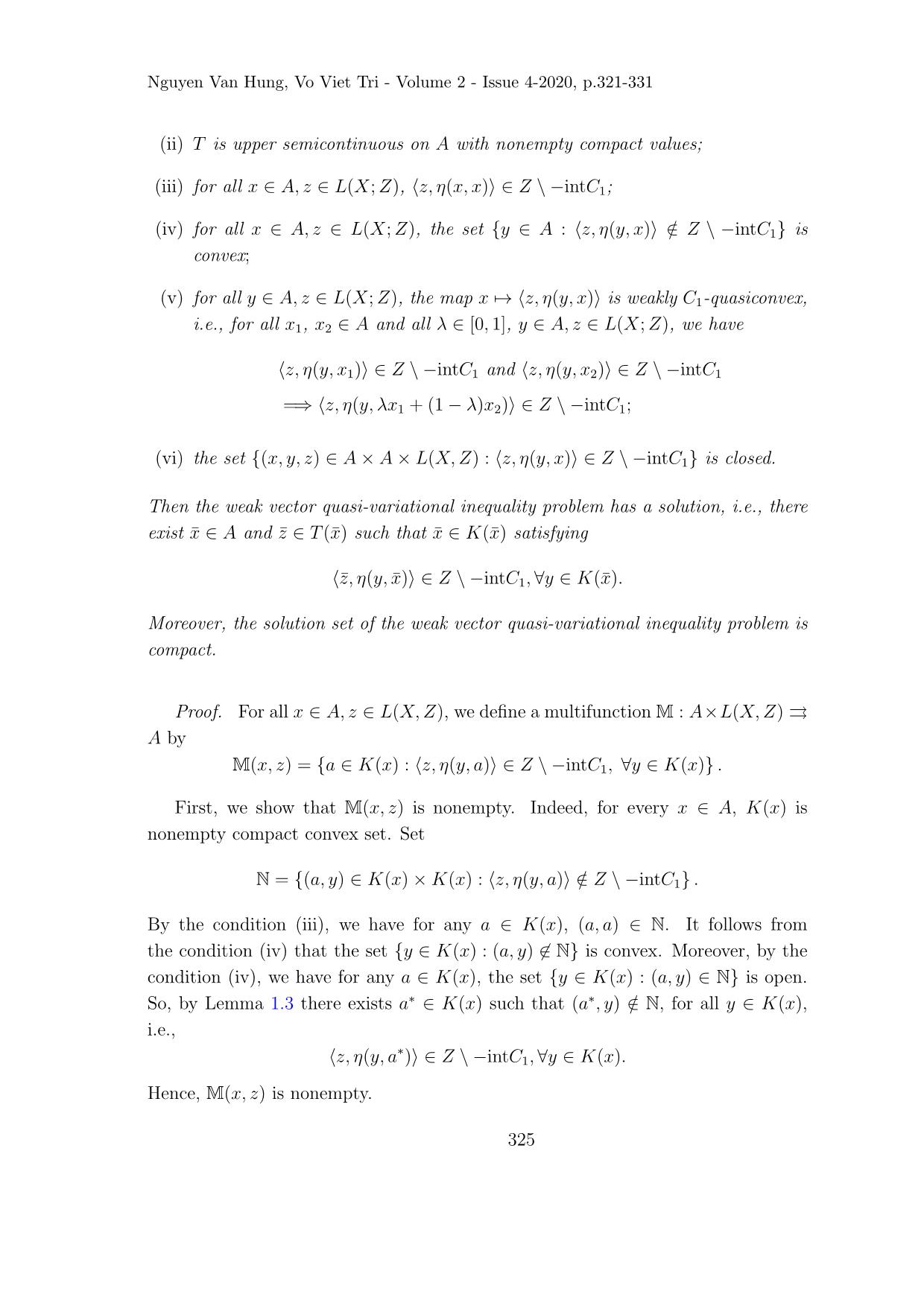
Trang 5
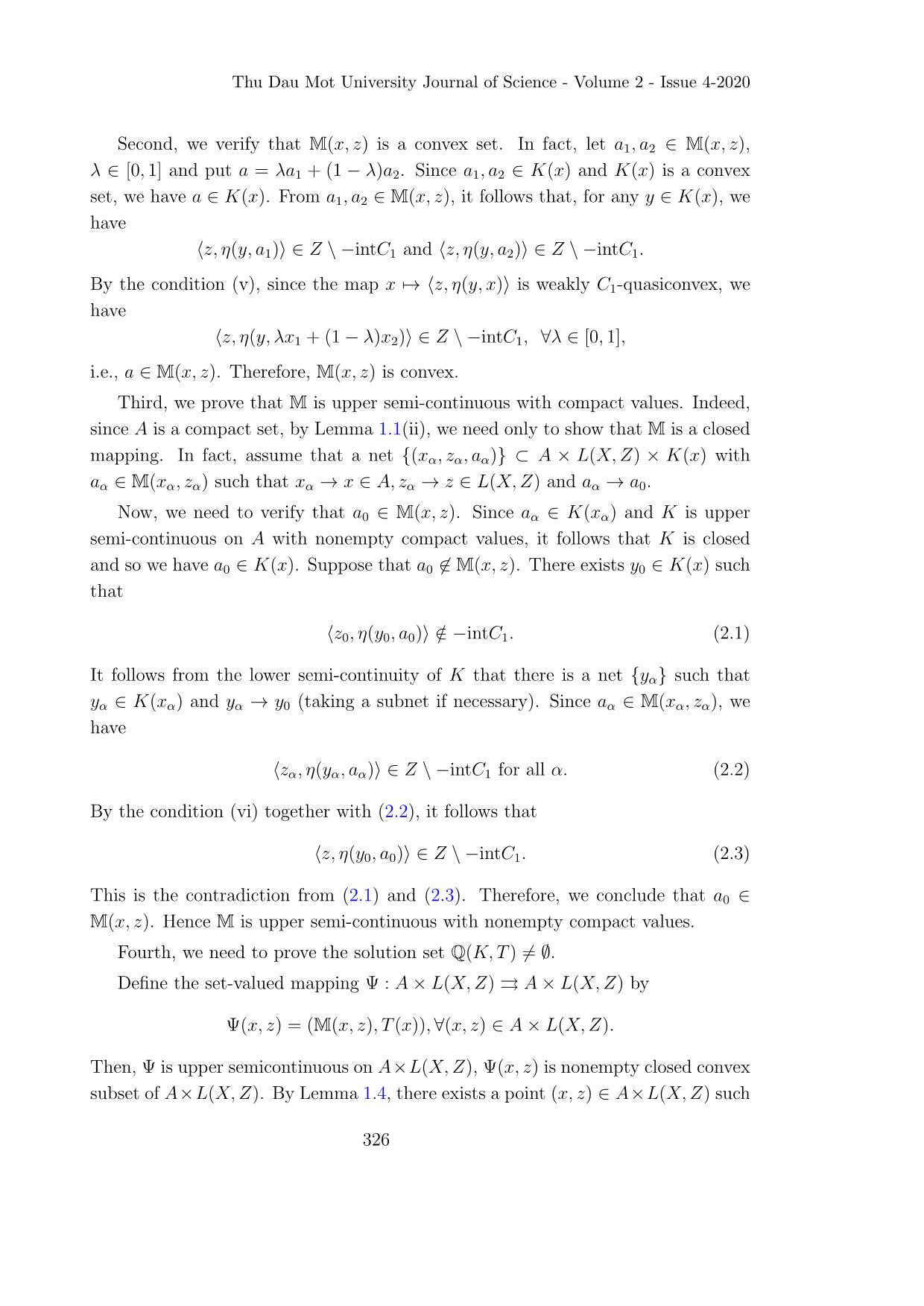
Trang 6
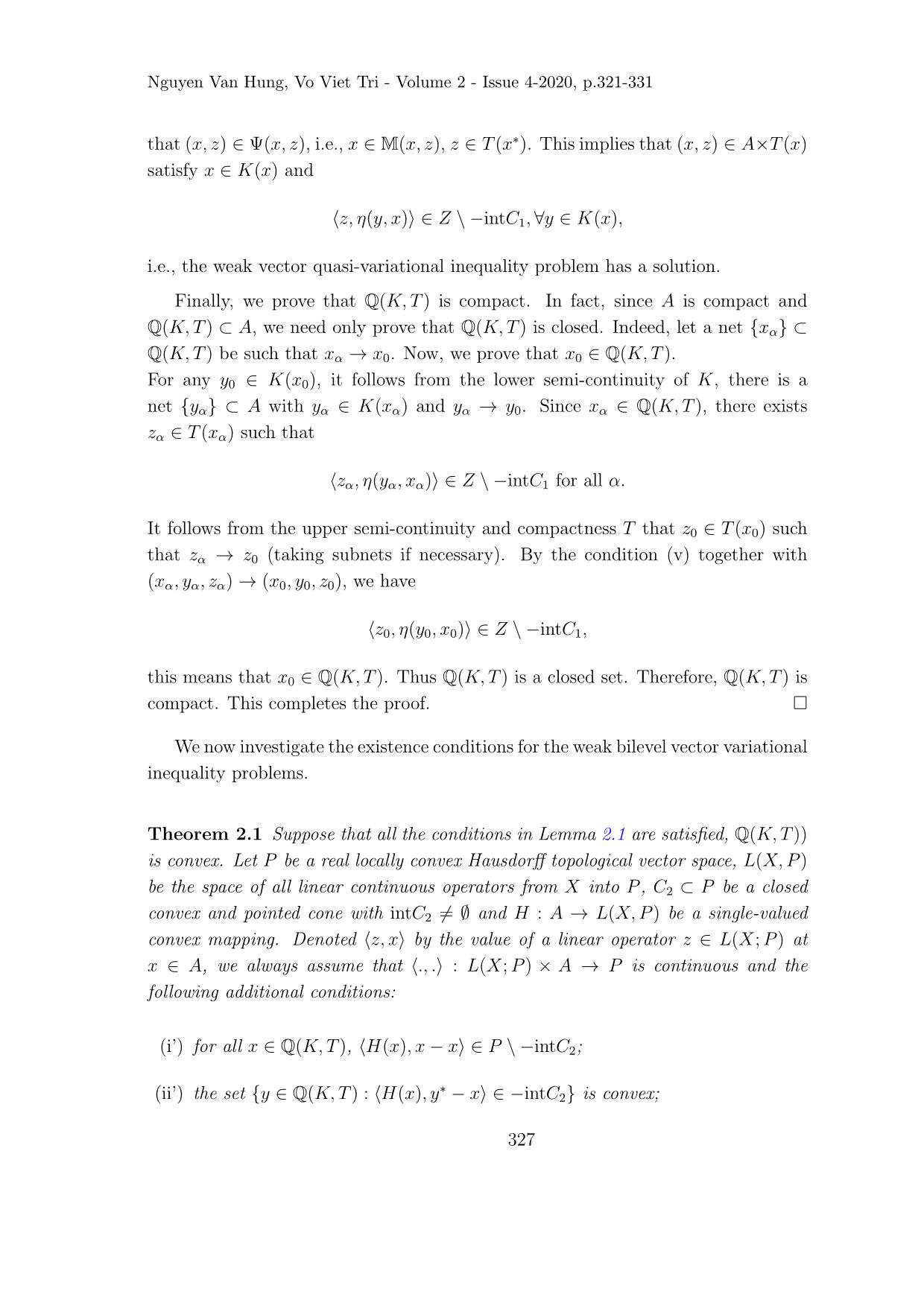
Trang 7
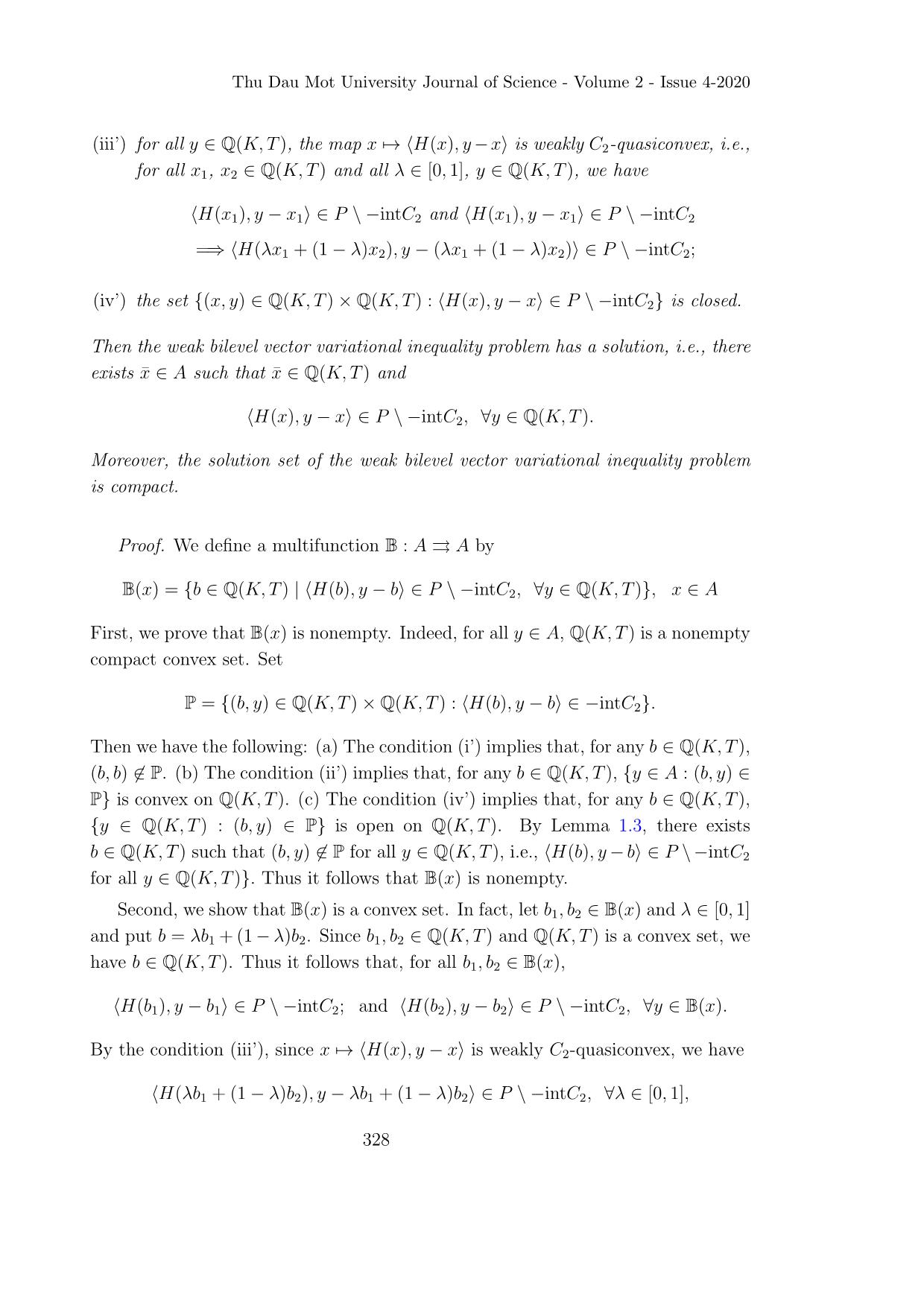
Trang 8

Trang 9
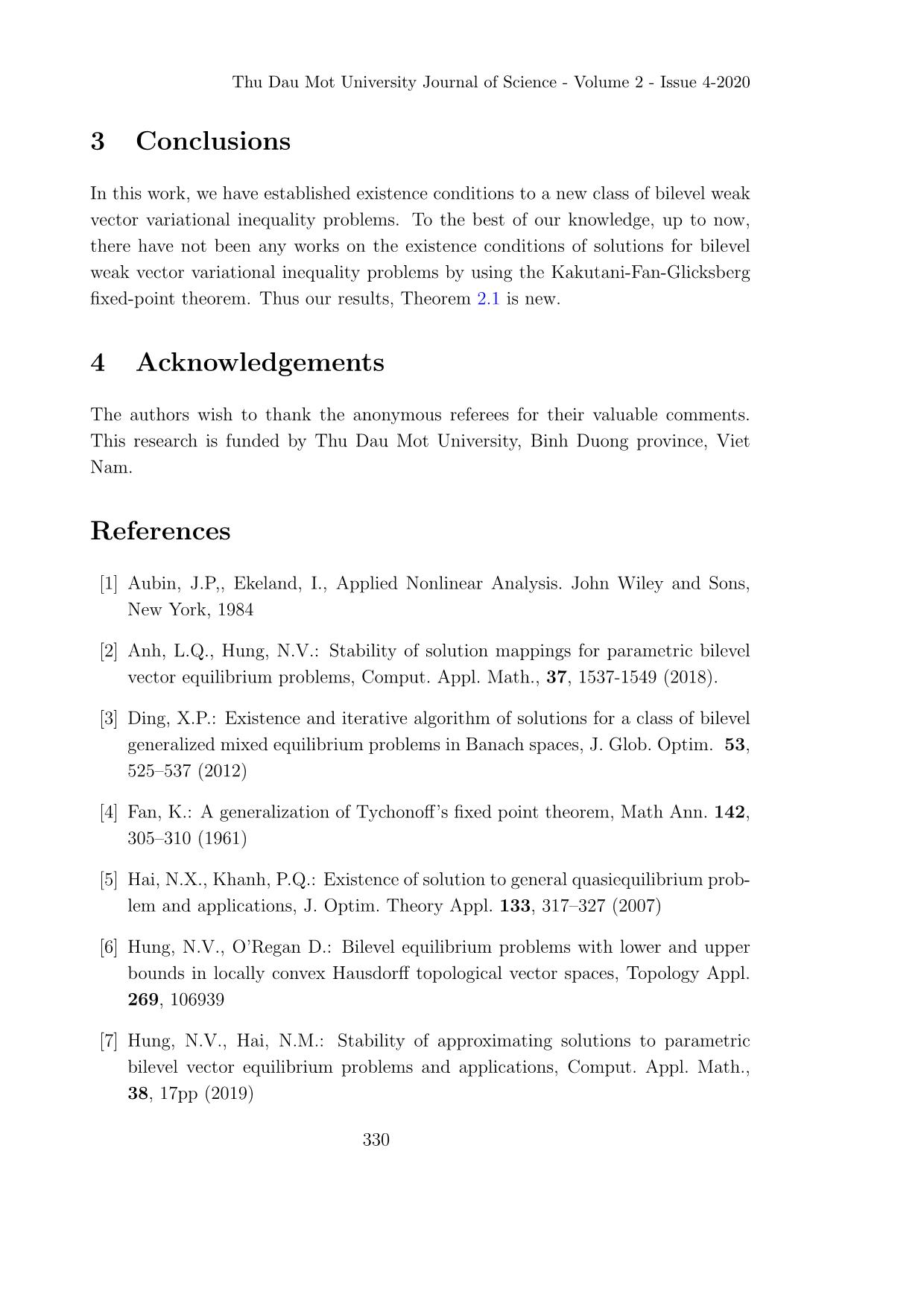
Trang 10
Tải về để xem bản đầy đủ
Bạn đang xem 10 trang mẫu của tài liệu "A new class of bilevel weak vector variational inequality problems", để tải tài liệu gốc về máy hãy click vào nút Download ở trên
Tóm tắt nội dung tài liệu: A new class of bilevel weak vector variational inequality problems
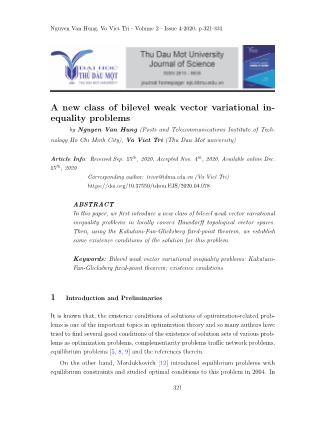
usc (lsc, continuous, closed, respectively) at all x ∈ domF ∩ A. If
A ≡ X, then we omit “on X” in the statement.
Lemma 1.1 (see [1]) Let X, Y be two topological vector spaces and F : X ⇒ Y be
a multifunction. Then we have the following:
(1) If F is upper semi-continuous with closed values, then F is closed.
(2) If F is closed and F (X) is compact, then F is upper semi-continuous.
Lemma 1.2 (see [1]) Let X, Y be two topological vector spaces and F : X ⇒ Y be
a multifunction. Then we have the following:
(1) F is lower semi-continuous x0 ∈ X if and only if, for each net {xα} ⊆ X
which converges to x0 ∈ X and for each y0 ∈ F (x0), there exists {yα} in Y
such that yα ∈ F (xα), yα → y0.
(2) If F has compact values, then F is upper semi-continuous x0 ∈ X if and only
if, for each net {xα} ⊆ X which converges to x0 ∈ X and for each net {yα}
in Y such that yα ∈ F (xα), there exist y0 ∈ F (x0) and a subnet {yβ} of {yα}
such that yβ → y0.
Lemma 1.3 (see [4]) Let A be a nonempty convex compact subset of Hausdorff
topological vector space X and N be a subset of A × A such that
323
Thu Dau Mot University Journal of Science - Volume 2 - Issue 4-2020
(i) for each at x ∈ A, (x, x) 6∈ N;
(ii) for each at y ∈ A, the set {x ∈ A :(x, y) ∈ N} is open on A;
(iii) for each at x ∈ A, the set {y ∈ A :(x, y) ∈ N} is convex or empty.
Then there exists x0 ∈ A such that (x0, y) 6∈ N for all y ∈ A.
Lemma 1.4 (see [11]) Let A be a nonempty compact convex subset of a locally
convex Hausdorff vector topological space X. If F : A ⇒ A is upper semi-continuous
and, for any x ∈ A, F (x) is nonempty convex closed, then there exists x∗ ∈ A such
that x∗ ∈ F (x∗).
2 Main Results
In this section, we establish some existence results for weak bilevel vector quasi-
variational inequality problems.
We first introduce the concept of weakly C-quasiconvexity.
Definition 2.1 Let X, Z be two topological vector spaces, A be a nonempty closed
subset of X, and C ⊂ Z is a solid pointed closed convex cone and f : A → Z be a
function.The mapping f is said to be weakly C-quasiconvex on A ⊂ X if, for each
x1, x2 ∈ A, λ ∈ [0, 1] with f(x1) ∈ Z \ −intC and f(x2) ∈ Z \ −intC, we have
f((1 − λ)x1 + λx2) ∈ Z \ −intC,
We now establish some existence conditions of solution sets of the weak vector
quasi-variational inequality problems.
Lemma 2.1 Let X, Z be real locally convex Hausdorff topological vector spaces,
L(X, Z) be the space of all linear continuous operators from X into Z, A be a
nonempty compact subset of X and C1 ⊂ Z be a closed convex and pointed cone with
intC1 6= ∅, where intC1 is the interior of C1. Let K : A ⇒ A and T : A ⇒ L(X, Z)
be multifunctions, η : A × A → A be a continuous single-valued mapping. Denoted
hz, xi by the value of a linear operator z ∈ L(X; Z) at x ∈ A, we always assume
that h., .i : L(X; Z) × A → Z is continuous. Suppose the following conditions:
(i) K is continuous on A with nonempty compact convex values;
324
Nguyen Van Hung, Vo Viet Tri - Volume 2 - Issue 4-2020, p.321-331
(ii) T is upper semicontinuous on A with nonempty compact values;
(iii) for all x ∈ A, z ∈ L(X; Z), hz, η(x, x)i ∈ Z \ −intC1;
(iv) for all x ∈ A, z ∈ L(X; Z), the set {y ∈ A : hz, η(y, x)i ∈/ Z \ −intC1} is
convex;
(v) for all y ∈ A, z ∈ L(X; Z), the map x 7→ hz, η(y, x)i is weakly C1-quasiconvex,
i.e., for all x1, x2 ∈ A and all λ ∈ [0, 1], y ∈ A, z ∈ L(X; Z), we have
hz, η(y, x1)i ∈ Z \ −intC1 and hz, η(y, x2)i ∈ Z \ −intC1
=⇒ hz, η(y, λx1 + (1 − λ)x2)i ∈ Z \ −intC1;
(vi) the set {(x, y, z) ∈ A × A × L(X, Z): hz, η(y, x)i ∈ Z \ −intC1} is closed.
Then the weak vector quasi-variational inequality problem has a solution, i.e., there
exist x¯ ∈ A and z¯ ∈ T (¯x) such that x¯ ∈ K(¯x) satisfying
hz,¯ η(y, x¯)i ∈ Z \ −intC1, ∀y ∈ K(¯x).
Moreover, the solution set of the weak vector quasi-variational inequality problem is
compact.
Proof. For all x ∈ A, z ∈ L(X, Z), we define a multifunction M : A×L(X, Z) ⇒
A by
M(x, z) = {a ∈ K(x): hz, η(y, a)i ∈ Z \ −intC1, ∀y ∈ K(x)} .
First, we show that M(x, z) is nonempty. Indeed, for every x ∈ A, K(x) is
nonempty compact convex set. Set
N = {(a, y) ∈ K(x) × K(x): hz, η(y, a)i ∈/ Z \ −intC1} .
By the condition (iii), we have for any a ∈ K(x), (a, a) ∈ N. It follows from
the condition (iv) that the set {y ∈ K(x):(a, y) 6∈ N} is convex. Moreover, by the
condition (iv), we have for any a ∈ K(x), the set {y ∈ K(x):(a, y) ∈ N} is open.
So, by Lemma 1.3 there exists a∗ ∈ K(x) such that (a∗, y) ∈/ N, for all y ∈ K(x),
i.e.,
∗
hz, η(y, a )i ∈ Z \ −intC1, ∀y ∈ K(x).
Hence, M(x, z) is nonempty.
325
Thu Dau Mot University Journal of Science - Volume 2 - Issue 4-2020
Second, we verify that M(x, z) is a convex set. In fact, let a1, a2 ∈ M(x, z),
λ ∈ [0, 1] and put a = λa1 + (1 − λ)a2. Since a1, a2 ∈ K(x) and K(x) is a convex
set, we have a ∈ K(x). From a1, a2 ∈ M(x, z), it follows that, for any y ∈ K(x), we
have
hz, η(y, a1)i ∈ Z \ −intC1 and hz, η(y, a2)i ∈ Z \ −intC1.
By the condition (v), since the map x 7→ hz, η(y, x)i is weakly C1-quasiconvex, we
have
hz, η(y, λx1 + (1 − λ)x2)i ∈ Z \ −intC1, ∀λ ∈ [0, 1],
i.e., a ∈ M(x, z). Therefore, M(x, z) is convex.
Third, we prove that M is upper semi-continuous with compact values. Indeed,
since A is a compact set, by Lemma 1.1(ii), we need only to show that M is a closed
mapping. In fact, assume that a net {(xα, zα, aα)} ⊂ A × L(X, Z) × K(x) with
aα ∈ M(xα, zα) such that xα → x ∈ A, zα → z ∈ L(X, Z) and aα → a0.
Now, we need to verify that a0 ∈ M(x, z). Since aα ∈ K(xα) and K is upper
semi-continuous on A with nonempty compact values, it follows that K is closed
and so we have a0 ∈ K(x). Suppose that a0 6∈ M(x, z). There exists y0 ∈ K(x) such
that
hz0, η(y0, a0)i ∈/ −intC1. (2.1)
It follows from the lower semi-continuity of K that there is a net {yα} such that
yα ∈ K(xα) and yα → y0 (taking a subnet if necessary). Since aα ∈ M(xα, zα), we
have
hzα, η(yα, aα)i ∈ Z \ −intC1 for all α. (2.2)
By the condition (vi) together with (2.2), it follows that
hz, η(y0, a0)i ∈ Z \ −intC1. (2.3)
This is the contradiction from (2.1) and (2.3). Therefore, we conclude that a0 ∈
M(x, z). Hence M is upper semi-continuous with nonempty compact values.
Fourth, we need to prove the solution set Q(K, T ) 6= ∅.
Define the set-valued mapping Ψ : A × L(X, Z) ⇒ A × L(X, Z) by
Ψ(x, z) = (M(x, z),T (x)), ∀(x, z) ∈ A × L(X, Z).
Then, Ψ is upper semicontinuous on A×L(X, Z), Ψ(x, z) is nonempty closed convex
subset of A×L(X, Z). By Lemma 1.4, there exists a point (x, z) ∈ A×L(X, Z) such
326
Nguyen Van Hung, Vo Viet Tri - Volume 2 - Issue 4-2020, p.321-331
that (x, z) ∈ Ψ(x, z), i.e., x ∈ M(x, z), z ∈ T (x∗). This implies that (x, z) ∈ A×T (x)
satisfy x ∈ K(x) and
hz, η(y, x)i ∈ Z \ −intC1, ∀y ∈ K(x),
i.e., the weak vector quasi-variational inequality problem has a solution.
Finally, we prove that Q(K, T ) is compact. In fact, since A is compact and
Q(K, T ) ⊂ A, we need only prove that Q(K, T ) is closed. Indeed, let a net {xα} ⊂
Q(K, T ) be such that xα → x0. Now, we prove that x0 ∈ Q(K, T ).
For any y0 ∈ K(x0), it follows from the lower semi-continuity of K, there is a
net {yα} ⊂ A with yα ∈ K(xα) and yα → y0. Since xα ∈ Q(K, T ), there exists
zα ∈ T (xα) such that
hzα, η(yα, xα)i ∈ Z \ −intC1 for all α.
It follows from the upper semi-continuity and compactness T that z0 ∈ T (x0) such
that zα → z0 (taking subnets if necessary). By the condition (v) together with
(xα, yα, zα) → (x0, y0, z0), we have
hz0, η(y0, x0)i ∈ Z \ −intC1,
this means that x0 ∈ Q(K, T ). Thus Q(K, T ) is a closed set. Therefore, Q(K, T ) is
compact. This completes the proof.
We now investigate the existence conditions for the weak bilevel vector variational
inequality problems.
Theorem 2.1 Suppose that all the conditions in Lemma 2.1 are satisfied, Q(K, T ))
is convex. Let P be a real locally convex Hausdorff topological vector space, L(X, P )
be the space of all linear continuous operators from X into P , C2 ⊂ P be a closed
convex and pointed cone with intC2 6= ∅ and H : A → L(X, P ) be a single-valued
convex mapping. Denoted hz, xi by the value of a linear operator z ∈ L(X; P ) at
x ∈ A, we always assume that h., .i : L(X; P ) × A → P is continuous and the
following additional conditions:
(i’) for all x ∈ Q(K, T ), hH(x), x − xi ∈ P \ −intC2;
∗
(ii’) the set {y ∈ Q(K, T ): hH(x), y − xi ∈ −intC2} is convex;
327
Thu Dau Mot University Journal of Science - Volume 2 - Issue 4-2020
(iii’) for all y ∈ Q(K, T ), the map x 7→ hH(x), y −xi is weakly C2-quasiconvex, i.e.,
for all x1, x2 ∈ Q(K, T ) and all λ ∈ [0, 1], y ∈ Q(K, T ), we have
hH(x1), y − x1i ∈ P \ −intC2 and hH(x1), y − x1i ∈ P \ −intC2
=⇒ hH(λx1 + (1 − λ)x2), y − (λx1 + (1 − λ)x2)i ∈ P \ −intC2;
(iv’) the set {(x, y) ∈ Q(K, T ) × Q(K, T ): hH(x), y − xi ∈ P \ −intC2} is closed.
Then the weak bilevel vector variational inequality problem has a solution, i.e., there
exists x¯ ∈ A such that x¯ ∈ Q(K, T ) and
hH(x), y − xi ∈ P \ −intC2, ∀y ∈ Q(K, T ).
Moreover, the solution set of the weak bilevel vector variational inequality problem
is compact.
Proof. We define a multifunction B : A ⇒ A by
B(x) = {b ∈ Q(K, T ) | hH(b), y − bi ∈ P \ −intC2, ∀y ∈ Q(K, T )}, x ∈ A
First, we prove that B(x) is nonempty. Indeed, for all y ∈ A, Q(K, T ) is a nonempty
compact convex set. Set
P = {(b, y) ∈ Q(K, T ) × Q(K, T ): hH(b), y − bi ∈ −intC2}.
Then we have the following: (a) The condition (i’) implies that, for any b ∈ Q(K, T ),
(b, b) 6∈ P. (b) The condition (ii’) implies that, for any b ∈ Q(K, T ), {y ∈ A :(b, y) ∈
P} is convex on Q(K, T ). (c) The condition (iv’) implies that, for any b ∈ Q(K, T ),
{y ∈ Q(K, T ):(b, y) ∈ P} is open on Q(K, T ). By Lemma 1.3, there exists
b ∈ Q(K, T ) such that (b, y) 6∈ P for all y ∈ Q(K, T ), i.e., hH(b), y − bi ∈ P \ −intC2
for all y ∈ Q(K, T )}. Thus it follows that B(x) is nonempty.
Second, we show that B(x) is a convex set. In fact, let b1, b2 ∈ B(x) and λ ∈ [0, 1]
and put b = λb1 + (1 − λ)b2. Since b1, b2 ∈ Q(K, T ) and Q(K, T ) is a convex set, we
have b ∈ Q(K, T ). Thus it follows that, for all b1, b2 ∈ B(x),
hH(b1), y − b1i ∈ P \ −intC2; and hH(b2), y − b2i ∈ P \ −intC2, ∀y ∈ B(x).
By the condition (iii’), since x 7→ hH(x), y − xi is weakly C2-quasiconvex, we have
hH(λb1 + (1 − λ)b2), y − λb1 + (1 − λ)b2i ∈ P \ −intC2, ∀λ ∈ [0, 1],
328
Nguyen Van Hung, Vo Viet Tri - Volume 2 - Issue 4-2020, p.321-331
i.e., b ∈ B(x). Thus, B(x) is convex.
Third, we prove that B is upper semi-continuous on A with compact values.
Indeed, since A is a compact set, by Lemma 1.1 (ii), we need only to show that B is
a closed mapping. Let a net {xα} ⊂ A be such that xα → x ∈ A and let bα ∈ B(xα)
be such that bα → b0.
Now, we need to show that b0 ∈ B(x). Since bα ∈ Q(K, T ) and Q(K, T ) is
compact, we have b0 ∈ Q(K, T ). Suppose that b0 6∈ B(x). Then there exists
y ∈ Q(K, T ) such that
hH(b0), y − b0i ∈ −intC2. (2.4)
On the other hand, since bα ∈ B(xα), we have
hH(bα), y − bαi ∈ P \ −intC2 for all α. (2.5)
By the condition (iv’) together with (2.5), it follows that
hH(b0), y − b0i ∈ P \ −intC2, (2.6)
which is a contradiction from (2.4) and (2.6). Thus b0 ∈ B(x). Hence B is upper
semi-continuous on A with nonempty compact values.
Fourth, we prove that the solution set O(H) is nonempty. In fact, since B is
upper semi-continuous on A with nonempty compact values, by Lemma 1.4, there
exists a pointx ˆ ∈ A such thatx ˆ ∈ B(ˆx). Hence there existsx ˆ ∈ Q(K, T ) such that
hH(ˆx), y − xˆi ∈ P \ −intC2, ∀y ∈ Q(K, T ),
i.e., the problem (WBVIP) has a solution.
Finally, we prove that O(H) is compact. Indeed, let a net {xα} ⊂ O(H) be such
that xα → x0. Now, we prove that x0 ∈ O(H). By the closedness of Q(K, T ), we
have x0 ∈ Q(K, T ). Since xα ∈ O(H), we obtain xα ∈ Q(K, T ) and
hH(xα), y − xαi ∈ P \ −intC2, ∀y ∈ Q(K, T ).
By the condition (iv’) together with xα → x0, it follows that
hH(x0), y − x0i ∈ P \ −intC2, ∀y ∈ Q(K, T ),
which means that x0 ∈ O(H). Thus O(H) is a closed set. Since O(H) ⊂ Q(K, T )
and Q(K, T ) is compact. It follows that O(H) is compact subset of A. This com-
pletes the proof.
329
Thu Dau Mot University Journal of Science - Volume 2 - Issue 4-2020
3 Conclusions
In this work, we have established existence conditions to a new class of bilevel weak
vector variational inequality problems. To the best of our knowledge, up to now,
there have not been any works on the existence conditions of solutions for bilevel
weak vector variational inequality problems by using the Kakutani-Fan-Glicksberg
fixed-point theorem. Thus our results, Theorem 2.1 is new.
4 Acknowledgements
The authors wish to thank the anonymous referees for their valuable comments.
This research is funded by Thu Dau Mot University, Binh Duong province, Viet
Nam.
References
[1] Aubin, J.P,, Ekeland, I., Applied Nonlinear Analysis. John Wiley and Sons,
New York, 1984
[2] Anh, L.Q., Hung, N.V.: Stability of solution mappings for parametric bilevel
vector equilibrium problems, Comput. Appl. Math., 37, 1537-1549 (2018).
[3] Ding, X.P.: Existence and iterative algorithm of solutions for a class of bilevel
generalized mixed equilibrium problems in Banach spaces, J. Glob. Optim. 53,
525–537 (2012)
[4] Fan, K.: A generalization of Tychonoff’s fixed point theorem, Math Ann. 142,
305–310 (1961)
[5] Hai, N.X., Khanh, P.Q.: Existence of solution to general quasiequilibrium prob-
lem and applications, J. Optim. Theory Appl. 133, 317–327 (2007)
[6] Hung, N.V., O’Regan D.: Bilevel equilibrium problems with lower and upper
bounds in locally convex Hausdorff topological vector spaces, Topology Appl.
269, 106939
[7] Hung, N.V., Hai, N.M.: Stability of approximating solutions to parametric
bilevel vector equilibrium problems and applications, Comput. Appl. Math.,
38, 17pp (2019)
330
Nguyen Van Hung, Vo Viet Tri - Volume 2 - Issue 4-2020, p.321-331
[8] Hung, N.V., Kobis, E., Tam, V.M.: Existence of solutions and iterative algo-
rithms for weak vector quasi-equilibrium problems, J. Nonlinear Convex Anal.
21, 463-478 (2020)
[9] Hung, N.V., Tam, V.M., Kobis, E., Yao, J.C: Existence of solutions and algo-
rithm for generalized vector quasi-complementarity problems with application
to traffic network problems, J. Nonlinear Convex Anal. 20, 1751-1775 (2019)
[10] Hung, N.V., Tri, V.V., O’Regan D.: Existence conditions for solutions of bilevel
vector equilibrium problems with application to traffic network problems with
equilibrium constraints, Positivity, (2020), online first.
[11] Holmes, R.B.: Geometric Functional Analysis and its Application. Springer-
Verlag, New York, (1975)
[12] Mordukhovich, B.S.: Equilibrium problems with equilibrium constraints via
multiobjective optimization. Optim. Methods Softw. 19, 479–492 (2004)
331File đính kèm:
 a_new_class_of_bilevel_weak_vector_variational_inequality_pr.pdf
a_new_class_of_bilevel_weak_vector_variational_inequality_pr.pdf

